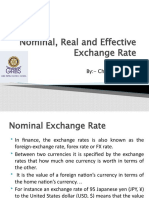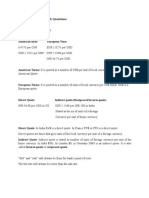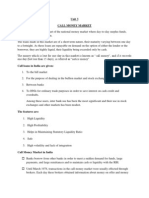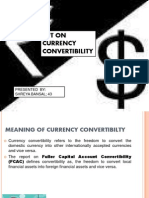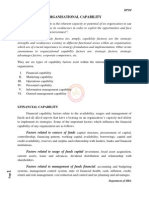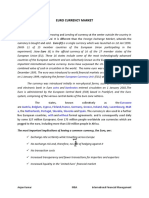Echange Rate Mechanism: 1. Direct Quote 2. Indirect Quote
Echange Rate Mechanism: 1. Direct Quote 2. Indirect Quote
Uploaded by
anjankumarCopyright:
Available Formats
Echange Rate Mechanism: 1. Direct Quote 2. Indirect Quote
Echange Rate Mechanism: 1. Direct Quote 2. Indirect Quote
Uploaded by
anjankumarOriginal Title
Copyright
Available Formats
Share this document
Did you find this document useful?
Is this content inappropriate?
Copyright:
Available Formats
Echange Rate Mechanism: 1. Direct Quote 2. Indirect Quote
Echange Rate Mechanism: 1. Direct Quote 2. Indirect Quote
Uploaded by
anjankumarCopyright:
Available Formats
ECHANGE RATE MECHANISM
In a foreign exchange market where different currencies are bought and sold, it is
essential to know the ratio between different currencies, how many units of one currency well
equal one unit of another currency. The ratio between two currencies is known as an exchange
rate. The various exchange rates are regularly quoted in newspapers and periodicals.
Major currencies in the world:
USD, EURO, YEN, GBP, CAN$, SWISS FRANC, AUS$
There are two methods for quoting exchange rates.
1. Direct quote
2. Indirect quote
Direct quote:
A direct quote gives the home currency price of a certain amount of foreign currency
usually one or 100units. If India quotes the exchange rate between the rupee and the us dollar
in a direct way the quotation will be written as Rs.35/US$. Direct quote places domestic
currency on the numerator of the quote.
Indirect Quote:
In the indirect quoting the value of one unit of home currency is presented in terms of
foreign currency. If India adopts indirect quotation, the banks in India will quote the exchange
rate as us$ 0.2857/Re. indirect quote domestic currency placed in denominator.
Buying and selling rates:
1
Normally, two rates are published one being the buying rate and the other the selling
Page
rate. The buying rate is also known as the bid rate. The selling rate is known as the ask rate or
offer rate. Bid rate always given first, followed by the ask rate quote.
Buying quote of a currency denotes the rate at which banks buy it. Selling quote at
which banks sell it. The banks need to make profit in these transactions, the selling quote is
higher than the buying the rate. The difference between these two quotes forms the banks
profit and is known as the spread.
Spread = (Ask price-Bid price)/ Ask price *100
Anjan Kumar MBA International Financial Management
Forward market quotation:
The quotes for the forward market are also published in the newspapers and periodicals. The
quoting rates may be expressed as outright quotes, or as swap quotes. The outright quote for the US
dollar in terms of the rupee can be written for different periods of forward contract as follows.
Spot one month three month
Rs.40.00-40.30 Rs. 39.80-40.20 Rs. 39.60-40.10
The swap quote on the other hand expresses only the difference between the spot
quote and the forward quote. It can be written as follows.
Spot one month three month
Rs.40.00-30 Rs. (20)-(10) Rs. (40)-(20)
Forward premium and discount:
The forward rates have longer maturity, the spread too gets wider. This is because of
uncertainty in the future that increases with lengthening of maturity. The changes in forward
rates may be upward or downwards. Such movements arise between spot and forward rates.
This is known as the swap or forward rate differential.
If the forward rate is lower than the spot rate, it well is a case of forward discount.
If the forward rate is higher than the spot rate it would be known as forward premium.
Forward premium or discount is expressed as an annualized percentage deviation from the spot
rate. It is computed as follows.
Forward Premium (Discount) = (n-day forward rate – spot rate)/spot rate * 360/n
2
Cross rates:
Page
The value of currency in terms of another one is not known directly. In such cases one
currency is sold for a common currency and again the common currency is exchanged for the
desired currency. This is known as cross rate trading and the rate established between the two
currencies is known as the cross rate.
Anjan Kumar MBA International Financial Management
Spot cross rate:
The selling rate of the Canadian dollar in Indian can be worked out by selling the rupee
for the US dollar at Rs.35.20/US$ and then buying Canadian dollar with the US dollar at C$
0.76/US$ .
Rs.35.20/US $ 1* US$ 1/C$0.76=Rs.46.32/C$
Forward Cross Rate:
The selling rate of one currency is divided by the buying rate of another currency and vice
versa. One month forward rate in case of the two currencies is Rs.34.50-34.80/US$ and C$ 0.79-
0.83/US$. The forward rate of the Canadian dollar in terms of the rupee can be found as:
Rs. 34.80/C$ 0.79 = Rs.44.05/C$
Rs. 34.50/C$0.83=Rs. 41.57
By combining the two we get Rs. 41.57-44.05/C$
NOMINAL, REAL AND EFFECTIVE EXCHANGE RATE:
Nominal exchange rates are also called bilateral exchange rates. It represents the ratio
between the values of two currencies at a particular point of time. Real exchange rates other
hand is the price adjusted nominal exchange rate. The relationship between nominal exchange
rate, e and the real exchange rate, er can be written in the form.
Er = eP/P*
Where p and p* are domestic and foreign price indices.
It is possible that the Indian rupee tends to depreciate against US dollar but it
appreciates against Japanese Yen. It is also possible that rupee depreciates vis-à-vis different
3 Page
currencies at different rates. so it is essential to develop an index or a summary measure of
how rupee fares, on an average, in the foreign exchange market. Such an index is called an
effective exchange rate. Effective exchange rate is the measure of the average value of a
currency relative to two or more currencies normally shown in the form of indices.
Anjan Kumar MBA International Financial Management
DETERMINATION OF EXCHANGE RATE IN THE SPOT MARKET
The exchange rate between two currencies in a floating rate regime is determined by
the interplay of demand and supply forces. The exchange rate between say the rupee and the
US dollar depends upon the demand for the US dollar and its availability or supply in the Indian
foreign exchange rate. The demand for foreign currency comes from individuals and firms who
have to make payments in foreign currency mostly on account of import of goods and services
and purchase of securities. The supply of foreign exchange results from the receipt of foreign
currencies normally on account of export or sale of financial securities to foreign entities.
Rs. /US $
S
S’
42
40
D’
D
Q1 Q2 Q3
Demand for and Supply of US $
FACTORS INFLUENCING EXCHANGE RATE:
Flow of funds on the current and capital accounts
4Page
Impact of inflation
Interest rate
DETERMINATION OF EXCHANGE RATE IN THE FORWARD MARKET
Forward exchange rate is normally not equal to the spot rate. The size of forward premium or
discount depends mainly on the current expectation of future events. The determination of
exchange rate in a forward market finds an important place in the theory of interest rate parity
(IRP). Covered interest rate Arbitrage, Uncovered interest rate arbitrage.
Anjan Kumar MBA International Financial Management
You might also like
- CHASE PRIVATE CLIENT CHECKING Statement For Account Ending in 5229 DaDocument4 pagesCHASE PRIVATE CLIENT CHECKING Statement For Account Ending in 5229 Darocky fletcher50% (2)
- Foundational Theories and Techniques for Risk Management, A Guide for Professional Risk Managers in Financial Services - Part II - Financial InstrumentsFrom EverandFoundational Theories and Techniques for Risk Management, A Guide for Professional Risk Managers in Financial Services - Part II - Financial InstrumentsNo ratings yet
- GA Taxes Delinquent-IndividualsDocument1,082 pagesGA Taxes Delinquent-IndividualsMcMillan ConsultingNo ratings yet
- Sage Pastel Partner Courses...Document9 pagesSage Pastel Partner Courses...Tanaka MpofuNo ratings yet
- Answers OPERATIONDocument6 pagesAnswers OPERATIONAltea AroganteNo ratings yet
- International Cash ManagementDocument52 pagesInternational Cash ManagementPanashe MachekepfuNo ratings yet
- Sunway T1 (TX4014) - Business IncomeDocument4 pagesSunway T1 (TX4014) - Business IncomeEe LynnNo ratings yet
- Distributor RoIDocument2 pagesDistributor RoIarchNo ratings yet
- Fera and Fema: Foreign Exchange Regulation Act & Foreign Exchange Management ActDocument8 pagesFera and Fema: Foreign Exchange Regulation Act & Foreign Exchange Management ActMayank JainNo ratings yet
- ANU Regular MBA-syllabusDocument45 pagesANU Regular MBA-syllabusVivek Anand80% (5)
- Nominal, Real and Effective Exchange RateDocument9 pagesNominal, Real and Effective Exchange Ratechiragec2550% (2)
- Foreign Exchange Rates CalculationsDocument14 pagesForeign Exchange Rates Calculationsnenu_1000% (1)
- Foreign Exchange RateDocument3 pagesForeign Exchange RatesamchannuNo ratings yet
- Basics of International FinanceDocument59 pagesBasics of International FinanceAnuj Joshi100% (1)
- Portfolio RevisionDocument10 pagesPortfolio Revisionsahiwalgurnoor100% (1)
- Foreign Exchange Determination SystemDocument15 pagesForeign Exchange Determination SystemUditanshu Misra100% (1)
- Foreign Exchange Market PDFDocument17 pagesForeign Exchange Market PDFHemanth KumarNo ratings yet
- Cross Rate-1Document3 pagesCross Rate-1Hola GamerNo ratings yet
- Role of RBI in FOREX MarketDocument14 pagesRole of RBI in FOREX Marketlagfdf88No ratings yet
- International FinanceDocument68 pagesInternational FinanceVenkata Raman RedrowtuNo ratings yet
- Foreign Exchange Rate QuotationsDocument6 pagesForeign Exchange Rate Quotationsalu_tNo ratings yet
- Two-Point Arbitrage: ProfitDocument6 pagesTwo-Point Arbitrage: ProfitLeo the BulldogNo ratings yet
- Role and Importance of Multinational Corporations in International BusinessDocument5 pagesRole and Importance of Multinational Corporations in International BusinessAdi ShahNo ratings yet
- Economic AnalysisDocument12 pagesEconomic AnalysiszaryNo ratings yet
- Forex Market in IndiaDocument24 pagesForex Market in IndiaHarshUpadhyayNo ratings yet
- Unit 2 Structure of of Options MarketsDocument36 pagesUnit 2 Structure of of Options MarketsTorreus AdhikariNo ratings yet
- Instruments of Trade Promotion in IndiaDocument12 pagesInstruments of Trade Promotion in Indiaphysics.gauravsir gauravsir100% (1)
- Wholesale Debt Market IndiaDocument9 pagesWholesale Debt Market IndiatawahidNo ratings yet
- Currency DerivativesDocument28 pagesCurrency DerivativesChetan Patel100% (1)
- Exchange Rate Theories: Prof Mahesh Kumar Amity Business SchoolDocument69 pagesExchange Rate Theories: Prof Mahesh Kumar Amity Business Schoolasifanis100% (2)
- BoP, CAD and Fiscal DeficitDocument10 pagesBoP, CAD and Fiscal DeficitPalak MehtaNo ratings yet
- IFM M.Com NotesDocument36 pagesIFM M.Com NotesViraja Guru0% (1)
- Derivatives Futures and Options Mba Project PDF FreeDocument92 pagesDerivatives Futures and Options Mba Project PDF FreeSauravNo ratings yet
- Foreign Exchange ManagementDocument152 pagesForeign Exchange Managementhimanshugupta6No ratings yet
- Research Project ReportDocument55 pagesResearch Project ReportharryNo ratings yet
- Unit 3 Call Money MarketDocument14 pagesUnit 3 Call Money MarketsadathnooriNo ratings yet
- An Impact of Currency Fluctuations On Indian Stock MarketDocument6 pagesAn Impact of Currency Fluctuations On Indian Stock MarketInternational Journal of Application or Innovation in Engineering & ManagementNo ratings yet
- Exchange Rate Theories: Dr. Amit SinhaDocument69 pagesExchange Rate Theories: Dr. Amit SinhaAmit SinhaNo ratings yet
- International FinanceDocument56 pagesInternational FinanceSucheta Das100% (1)
- Liquidity Theory of MoneyDocument6 pagesLiquidity Theory of MoneyMujadid MuzamilNo ratings yet
- Arbitrage Speculation and Hedging in ForDocument62 pagesArbitrage Speculation and Hedging in ForNihar RanjanNo ratings yet
- Portfolio Performance EvaluationDocument15 pagesPortfolio Performance EvaluationMohd NizamNo ratings yet
- Money Market's InstrumentsDocument20 pagesMoney Market's InstrumentsManmohan Prasad RauniyarNo ratings yet
- Components of Financial SystemDocument11 pagesComponents of Financial SystemromaNo ratings yet
- Mutual FundsDocument16 pagesMutual Fundsvirenshah_9846No ratings yet
- Money MarketDocument7 pagesMoney MarketShaimon JosephNo ratings yet
- Literature Review On Foreign ExchangeDocument6 pagesLiterature Review On Foreign ExchangeChetan Sahu0% (2)
- Balance of Payment Position of IndiaDocument15 pagesBalance of Payment Position of Indiavinodsurendran100% (3)
- Fundamental Analysis vs. Technical AnalysisDocument12 pagesFundamental Analysis vs. Technical AnalysisUmesh NandaNo ratings yet
- Evolution and Function of MoneyDocument14 pagesEvolution and Function of MoneyGhulam HasnainNo ratings yet
- Technical and Fundamental Analysis of Selected Securities of Indian Stock MarketDocument81 pagesTechnical and Fundamental Analysis of Selected Securities of Indian Stock MarketAbhijith V Ashok100% (1)
- Sebi GuidelinesDocument16 pagesSebi GuidelinesJerome P100% (1)
- Equilibrium and Disequilibrium in Balance of PaymentDocument9 pagesEquilibrium and Disequilibrium in Balance of PaymentDari ThangkhiewNo ratings yet
- Assignment 1 International Financial MangtDocument5 pagesAssignment 1 International Financial Mangtashu1286No ratings yet
- Portfolio RevisionDocument14 pagesPortfolio RevisionchitkarashellyNo ratings yet
- Managing Transaction ExposureDocument14 pagesManaging Transaction ExposureVarun KumarNo ratings yet
- On Currency ConvertibilityDocument19 pagesOn Currency ConvertibilityShreya Saransh Goel100% (1)
- Marginal Costing: Definition: (CIMA London)Document4 pagesMarginal Costing: Definition: (CIMA London)Pankaj2cNo ratings yet
- 6 International Parity Relationships and Forecasting Foreign Exchange RatesDocument57 pages6 International Parity Relationships and Forecasting Foreign Exchange Ratesreena2412No ratings yet
- Fixed IncomeDocument79 pagesFixed Incomeadas_16No ratings yet
- MCOM 104 International Financial ManagementDocument184 pagesMCOM 104 International Financial ManagementAniruddha ChakrabortyNo ratings yet
- Ch 4 Determination of Exchange RateDocument56 pagesCh 4 Determination of Exchange RateES PhantomNo ratings yet
- International Finance: Siddharth S. KanungoDocument83 pagesInternational Finance: Siddharth S. KanungoSingmay MoralNo ratings yet
- 3. Primer on Forex Markets and DerivativesDocument45 pages3. Primer on Forex Markets and DerivativesGajendaran JayakumarNo ratings yet
- Forex For CAIIBDocument6 pagesForex For CAIIBkushalnadekarNo ratings yet
- Users of Fundamental DataDocument1 pageUsers of Fundamental DataanjankumarNo ratings yet
- Business Policy and Strategic ManagementDocument11 pagesBusiness Policy and Strategic Managementanjankumar88% (16)
- BPSM 1Document6 pagesBPSM 1anjankumarNo ratings yet
- Note For Companies ActDocument3 pagesNote For Companies ActanjankumarNo ratings yet
- Indian Contract Act, 1872Document26 pagesIndian Contract Act, 1872manishettyNo ratings yet
- Consumer Protection Act1986: Who Is A Consumer? Sec.2 (1) (D)Document8 pagesConsumer Protection Act1986: Who Is A Consumer? Sec.2 (1) (D)anjankumarNo ratings yet
- Consumer Protection ActDocument15 pagesConsumer Protection ActanjankumarNo ratings yet
- Nature and Kinds of CompaniesDocument18 pagesNature and Kinds of CompaniesManish ShettyNo ratings yet
- Arbitration and ReconciliationDocument11 pagesArbitration and ReconciliationanjankumarNo ratings yet
- Foreign Exchange MarketDocument6 pagesForeign Exchange Marketanjankumar100% (1)
- NISM WorkbookDocument380 pagesNISM WorkbookcheetivenkatNo ratings yet
- Euro Currency MarketDocument8 pagesEuro Currency Marketanjankumar100% (6)
- Business Quiz: Kunda College of Technology and Managemenet Department of MbaDocument68 pagesBusiness Quiz: Kunda College of Technology and Managemenet Department of MbaanjankumarNo ratings yet
- Japfa SL Financing Framework - 20210305Document21 pagesJapfa SL Financing Framework - 20210305ahmadNo ratings yet
- Study Material CH.-1 Fundamentals of Partnership 2023-24Document28 pagesStudy Material CH.-1 Fundamentals of Partnership 2023-24vsy9926No ratings yet
- Chap03 - Industry and Competitive AnalysisDocument61 pagesChap03 - Industry and Competitive AnalysisNeeru AgarwalNo ratings yet
- Body ShopDocument2 pagesBody ShopVrullim BujaNo ratings yet
- Legal Requirements and Approvals Solar PanelsDocument3 pagesLegal Requirements and Approvals Solar PanelsCourtney JenningsNo ratings yet
- Carlsen Charters 2006 Global Wine TourismDocument298 pagesCarlsen Charters 2006 Global Wine TourismKiko LazzarottoNo ratings yet
- Evo PDFDocument25 pagesEvo PDFTinu ThomasNo ratings yet
- Omni Motors PVT LTD: Tax InvoiceDocument1 pageOmni Motors PVT LTD: Tax Invoicesayiw92029No ratings yet
- SLOM Sample Assignment 1Document39 pagesSLOM Sample Assignment 1mooglemanNo ratings yet
- Reimaginig Marketing in The Next Normal - McKinseyDocument7 pagesReimaginig Marketing in The Next Normal - McKinseyZhou JerryNo ratings yet
- Master of Laws LLMDocument5 pagesMaster of Laws LLMrolf_brNo ratings yet
- A Study On Impact of Covid-19 Pandemic On Unemployment in IndiaDocument13 pagesA Study On Impact of Covid-19 Pandemic On Unemployment in Indiaamit chavariaNo ratings yet
- Introduction To Economics IIDocument27 pagesIntroduction To Economics IIgeng09.khanNo ratings yet
- Banana ReportDocument28 pagesBanana Reportrapc80No ratings yet
- Summer Internship Project On SIP Mutual FundDocument97 pagesSummer Internship Project On SIP Mutual Fundrushil bhatiaNo ratings yet
- Vol V Issue IV Article 5Document6 pagesVol V Issue IV Article 5soniNo ratings yet
- Penny International College Jss I Business Studies First Term Scheme of WorkDocument19 pagesPenny International College Jss I Business Studies First Term Scheme of WorkAdio Babatunde Abiodun Cabax100% (4)
- Dissertation ReportDocument66 pagesDissertation ReportAditya Jain0% (1)
- OfficeDocument12 pagesOffice123r12f1100% (1)
- Invito Programma Evento Stresa MaggioDocument23 pagesInvito Programma Evento Stresa Maggiopietro silvestriNo ratings yet
- Bot AnDocument1 pageBot Anjosira6121No ratings yet
- Rift Valley University Assignment On Fundamental of Accounting II Submission Date January 10/2022Document2 pagesRift Valley University Assignment On Fundamental of Accounting II Submission Date January 10/2022Kat SullvianNo ratings yet
- Financial Institutions Management - Chapter 6 Solutions PDFDocument13 pagesFinancial Institutions Management - Chapter 6 Solutions PDFJarrod RodriguesNo ratings yet
- Chapter 9 Financial Reporting in Hyperinflationary EconomiesDocument17 pagesChapter 9 Financial Reporting in Hyperinflationary EconomiesCARPIO, JANELLA KEIZYNo ratings yet
- Cardholder Dispute Form ENGDocument1 pageCardholder Dispute Form ENGbmkhanNo ratings yet










